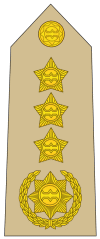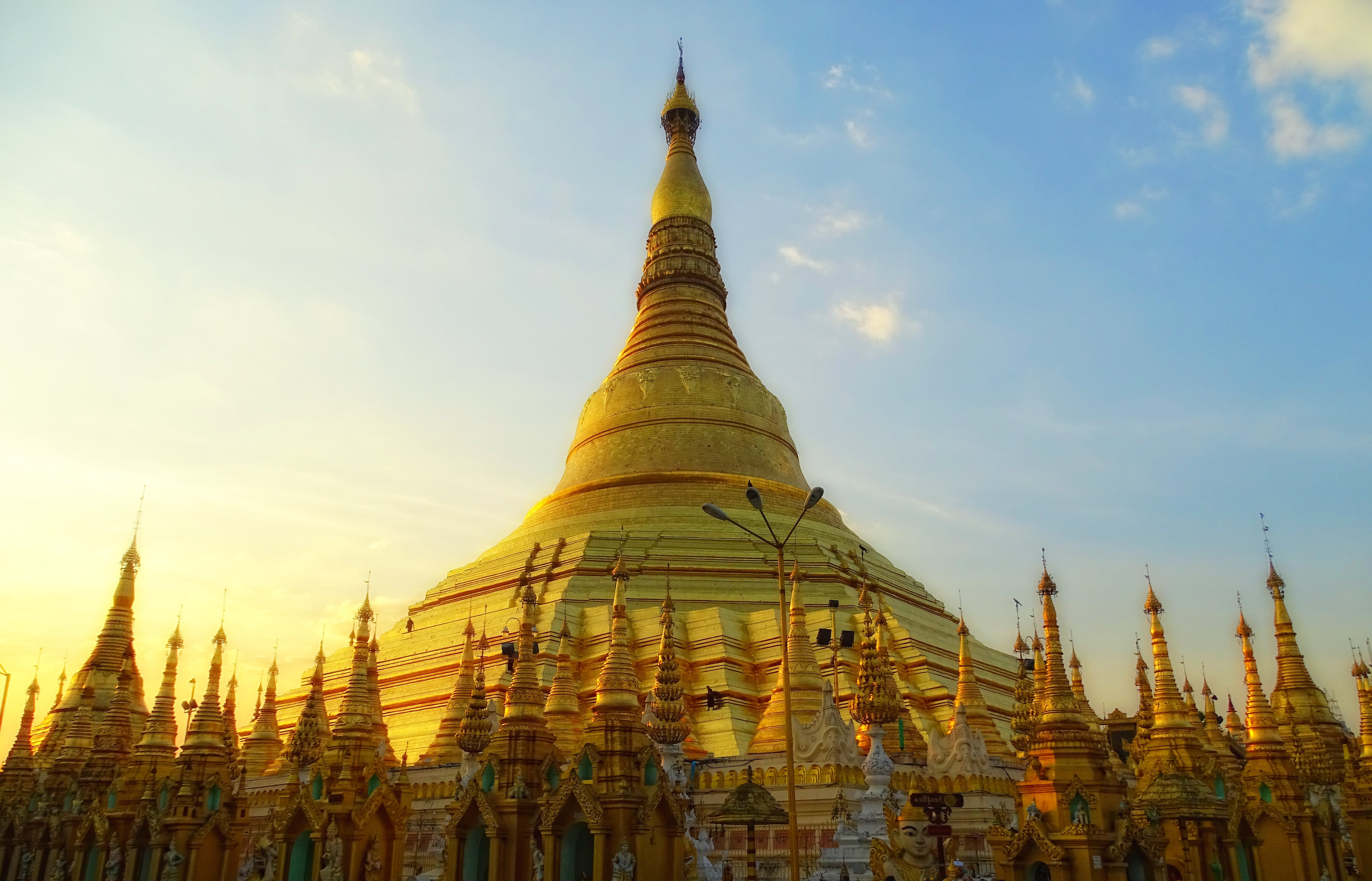|
Maha Wizaya Pagoda
The Maha Wizaya Pagoda ( my, မဟာဝိဇယစေတီ; pi, Māhavijayacetiya) is a pagoda located on Shwedagon Pagoda Road in Dagon Township, Yangon, Myanmar. The pagoda, built in 1980, is located immediately south of the Shwedagon Pagoda on Dhammarakhita Hill. The enshrined relics were contributed by the King of Nepal, while the pagoda's hti (umbrella) was consecrated by Ne Win, the country's former leader. The construction of this particular pagoda is believed by some scholars to have been a form of merit-making on the part of Ne Win. The pagoda was built to commemorate the convening of the First Congregation of All Orders for the Purification, Perpetuation and Propagation of Sasana in 1980, which formed the State Sangha Maha Nayaka Committee The State Saṅgha Mahā Nāyaka Committee ( my, နိုင်ငံတော် သံဃာ့မဟာနာယကအဖွဲ့, abbreviated Mahana or in Burmese, SSMNC in English) is a government-appointed body of h ... [...More Info...] [...Related Items...] OR: [Wikipedia] [Google] [Baidu] |
Dagon Township
Dagon Township ( my, ဒဂုံ မြို့နယ် ) is located immediately north of downtown Yangon. The township comprises five wards, and shares borders with Bahan Township in the north, Ahlon Township in the west, Mingala Taungnyunt Township in the east, and Lanmadaw Township, Latha Township and Pabedan Township in the south. Dagon is home to some of the most prominent places of the city, including the great Shwedagon Pagoda, the Maha Wizaya Pagoda, the National Museum, the National Theatre and the Yangon Region Hluttaw (Parliament). This prosperous neighborhood has many hotels, embassies and diplomatic residences. The township's Dagon 1 High School and Dagon 2 High School are considered among the top public high schools in the country. On 6 February 2011, the Taw Win Centre, a major shopping and residential complex, was opened in the township. Construction on the 25-story complex began in 2004, but was stopped during the country's banking crisis, before resuming i ... [...More Info...] [...Related Items...] OR: [Wikipedia] [Google] [Baidu] |
Yangon
Yangon ( my, ရန်ကုန်; ; ), formerly spelled as Rangoon, is the capital of the Yangon Region and the largest city of Myanmar (also known as Burma). Yangon served as the capital of Myanmar until 2006, when the military government relocated the administrative functions to the purpose-built capital city of Naypyidaw in north central Myanmar. With over 7 million people, Yangon is Myanmar's most populous city and its most important commercial centre. Yangon boasts the largest number of colonial-era buildings in Southeast Asia, and has a unique colonial-era urban core that is remarkably intact. The colonial-era commercial core is centered around the Sule Pagoda, which is reputed to be over 2,000 years old. The city is also home to the gilded Shwedagon Pagoda – Myanmar's most sacred and famous Buddhist pagoda. Yangon suffers from deeply inadequate infrastructure, especially compared to other major cities in Southeast Asia, such as Jakarta, Bangkok or Hanoi. Though ... [...More Info...] [...Related Items...] OR: [Wikipedia] [Google] [Baidu] |
Theravada Buddhism
''Theravāda'' () ( si, ථේරවාදය, my, ထေရဝါဒ, th, เถรวาท, km, ថេរវាទ, lo, ເຖຣະວາດ, pi, , ) is the most commonly accepted name of Buddhism's oldest existing school. The school's adherents, termed Theravādins, have preserved their version of Gautama Buddha's teaching or ''Dharma (Buddhism), Buddha Dhamma'' in the Pāli Canon for over two millennia. The Pāli Canon is the most complete Buddhist canon surviving in a Indo-Aryan languages, classical Indian language, Pali, Pāli, which serves as the school's sacred language and ''lingua franca''.Crosby, Kate (2013), ''Theravada Buddhism: Continuity, Diversity, and Identity'', p. 2. In contrast to ''Mahāyāna'' and ''Vajrayāna'', Theravāda tends to be conservative in matters of doctrine (''pariyatti'') and monastic discipline (''vinaya''). One element of this conservatism is the fact that Theravāda rejects the authenticity of the Mahayana sutras (which appeared c. ... [...More Info...] [...Related Items...] OR: [Wikipedia] [Google] [Baidu] |
Myanmar
Myanmar, ; UK pronunciations: US pronunciations incl. . Note: Wikipedia's IPA conventions require indicating /r/ even in British English although only some British English speakers pronounce r at the end of syllables. As John C. Wells, John Wells explains, the English spellings of both Myanmar and Burma assume a non-rhotic variety of English, in which the letter r before a consonant or finally serves merely to indicate a long vowel: [ˈmjænmɑː, ˈbɜːmə]. So the pronunciation of the last syllable of Myanmar as [mɑːr] or of Burma as [bɜːrmə] by some speakers in the UK and most speakers in North America is in fact a spelling pronunciation based on a misunderstanding of non-rhotic spelling conventions. The final ''r'' in ''Myanmar'' was not intended for pronunciation and is there to ensure that the final a is pronounced with the broad a, broad ''ah'' () in "father". If the Burmese name my, မြန်မာ, label=none were spelled "Myanma" in English, this would b ... [...More Info...] [...Related Items...] OR: [Wikipedia] [Google] [Baidu] |
Ne Win
Ne Win ( my, နေဝင်း ; 10 July 1910, or 14 or 24 May 1911 – 5 December 2002) was a Burmese politician and military commander who served as Prime Minister of Burma from 1958 to 1960 and 1962 to 1974, and also President of Burma from 1962 to 1981. Ne Win was Burma's military dictator during the Socialist Burma period of 1962 to 1988. Ne Win founded the Burma Socialist Programme Party (BSPP) and overthrew the democratic Union Parliament of U Nu in the 1962 Burmese coup d'état, establishing Burma as a one-party socialist state under the Burmese Way to Socialism ideology. Ne Win was Burma's ''de facto'' leader as chairman of the BSPP, serving in various official titles as part of his military government, and was known by his supporters as U Ne Win. His rule was characterized by a non-aligned foreign policy, isolationism, one-party rule, economic stagnation and superstition. Ne Win resigned in July 1988 in response to the 8888 Uprising that overthrew the BSPP, ... [...More Info...] [...Related Items...] OR: [Wikipedia] [Google] [Baidu] |
Maha Wizaya Pagoda
The Maha Wizaya Pagoda ( my, မဟာဝိဇယစေတီ; pi, Māhavijayacetiya) is a pagoda located on Shwedagon Pagoda Road in Dagon Township, Yangon, Myanmar. The pagoda, built in 1980, is located immediately south of the Shwedagon Pagoda on Dhammarakhita Hill. The enshrined relics were contributed by the King of Nepal, while the pagoda's hti (umbrella) was consecrated by Ne Win, the country's former leader. The construction of this particular pagoda is believed by some scholars to have been a form of merit-making on the part of Ne Win. The pagoda was built to commemorate the convening of the First Congregation of All Orders for the Purification, Perpetuation and Propagation of Sasana in 1980, which formed the State Sangha Maha Nayaka Committee The State Saṅgha Mahā Nāyaka Committee ( my, နိုင်ငံတော် သံဃာ့မဟာနာယကအဖွဲ့, abbreviated Mahana or in Burmese, SSMNC in English) is a government-appointed body of h ... [...More Info...] [...Related Items...] OR: [Wikipedia] [Google] [Baidu] |
Shwedagon Pagoda
The Shwedagon Pagoda (, ); mnw, ကျာ်ဒဂုၚ်; officially named ''Shwedagon Zedi Daw'' ( my, ရွှေတိဂုံစေတီတော်, , ) and also known as the Great Dagon Pagoda and the Golden Pagoda is a gilded stupa located in Yangon, Myanmar. The Shwedagon is the most sacred Buddhist pagoda in Myanmar, as it is believed to contain relics of the four previous Buddhas of the present kalpa. These relics include the staff of Kakusandha, the water filter of Koṇāgamana, a piece of the robe of Kassapa, and eight strands of hair from the head of Gautama. Built on the high Singuttara Hill, the tall pagoda stands above sea level,The pagoda's pinnacle height (to the tip of its ''hti'') is tall per (UNESCO 2018), and is built on the Singuttara Hill, which is tall per , and tall above sea level per and dominates the Yangon skyline. Yangon's zoning regulations, which cap the maximum height of buildings to above sea level (75% of the pagoda's sea ... [...More Info...] [...Related Items...] OR: [Wikipedia] [Google] [Baidu] |
Merit (Buddhism)
Merit ( sa, puṇya, italic=yes, pi, puñña, italic=yes) is a concept considered fundamental to Buddhist ethics. It is a beneficial and protective force which accumulates as a result of good deeds, acts, or thoughts. Merit-making is important to Buddhist practice: merit brings good and agreeable results, determines the quality of the next life and contributes to a person's growth towards enlightenment. In addition, merit is also shared with a deceased loved one, in order to help the deceased in their new existence. Despite modernization, merit-making remains essential in traditional Buddhist countries and has had a significant impact on the rural economies in these countries. Merit is connected with the notions of purity and goodness. Before Buddhism, merit was used with regard to ancestor worship, but in Buddhism it gained a more general ethical meaning. Merit is a force that results from good deeds done; it is capable of attracting good circumstances in a person's life, as ... [...More Info...] [...Related Items...] OR: [Wikipedia] [Google] [Baidu] |
State Sangha Maha Nayaka Committee
The State Saṅgha Mahā Nāyaka Committee ( my, နိုင်ငံတော် သံဃာ့မဟာနာယကအဖွဲ့, abbreviated Mahana or in Burmese, SSMNC in English) is a government-appointed body of high-ranking Buddhist monks that oversees and regulates the Sangha (Buddhist clergy) in Burma (Myanmar). History The Committee was formed after the First Congregation of All Orders for the Purification, Perpetuation and Propagation of Sasana, which sought to consolidate state control of the country's Sangha, was held in Rangoon (now Yangon) from 24 to 27 May 1980. The Congregation developed a hierarchy to regulate monks at the village tract/ward, state/division and national levels via committees and devised a central governing body of 33 members now called the state Sangha Maha Nayaka Committee, which would be responsible for all Buddhist monks in the country. The Committee also developed regulations to force monks to register and receive separate identificat ... [...More Info...] [...Related Items...] OR: [Wikipedia] [Google] [Baidu] |




